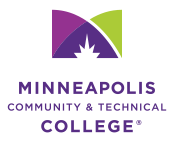History
Minneapolis College was founded as the Girls Vocational School in 1914 by its first principal, Miss Elizabeth Fish. When a new building at 1101 Third Avenue South was completed in 1932 it was renamed Mary Miller Vocational School, after the teacher credited with opening the first school in Minneapolis in 1852.
In the 1960s the name changed to Minneapolis Area Vocational Technical Institute. The school became Minneapolis Community College in 1965, and was the as the first campus of Metropolitan State Junior College. [3]
The name changed again to Metropolitan Community College in 1974. In 1979, the metropolitan system was broken up and the Minneapolis campus became Minneapolis Community College. [4]
The school entered the 1980s as Minneapolis Technical Institute on a new 418,000-square-foot (38,800 m2) campus at 1415 Hennepin Avenue. Its name was change was to Minneapolis Technical College (MTC). [5]
Minneapolis Community and Technical College (MCTC) was formed in February 1996 by the merger of Minneapolis Technical College and Minneapolis Community College following the July 1995 creation of MnSCU. [3] They had shared the same campus adjacent to Loring Park for many years.
In 2003, Minneapolis Community and Technical College acquired adjacent land that previously belonged to the Billy Graham Evangelistic Association's Minneapolis headquarters.
In 2004, Metropolitan State University (Metro State) and MCTC started sharing programs and Metro State's Minneapolis campus moved to the newly expanded MCTC campus from its original location a few blocks away. In fall 2008, the college opened a new Management Education Center and Science building on this property. By 2010, the only Metro State programs still operating on campus were theatre arts and business.
In 2022, the name was shortened to Minneapolis College.
Academics
Minneapolis College offers more than 100 career and occupational programs in aviation, business, education, health, information technology, justice system, manufacturing and construction, media arts, public service and the service industry. The college also has many clubs and societies, including a school newspaper. Minneapolis College has an Aviation Technician program at MSP airport, a Center for Criminal Justice in Saint Paul, and a Health Careers Institute in Minneapolis's Phillips neighborhood.
Minneapolis College competed with other community colleges in men's and women's basketball as the Mavericks. In 2009, at the end of a 33–2 season, the men's team lost to Richland College 58–57 in the NJCAA Division III National Championship. The school discontinued the basketball programs after the 2009–10 season. [10] [11]
This page is based on this
Wikipedia article Text is available under the
CC BY-SA 4.0 license; additional terms may apply.
Images, videos and audio are available under their respective licenses.


